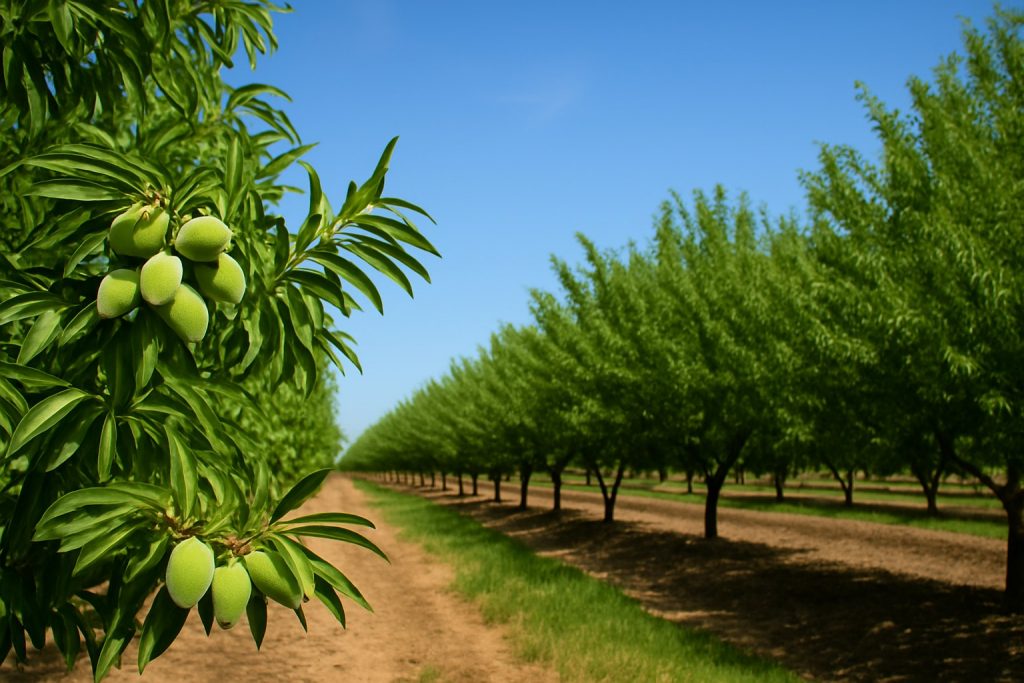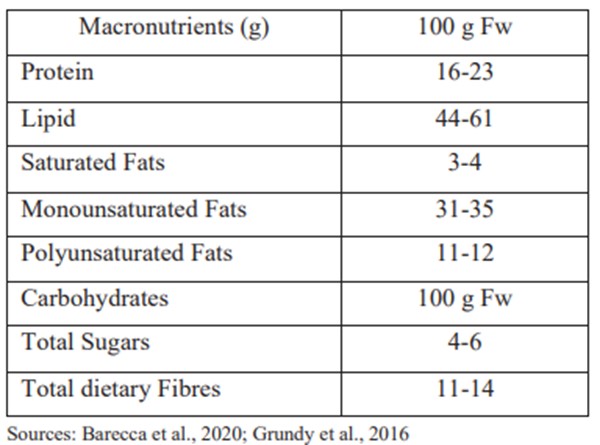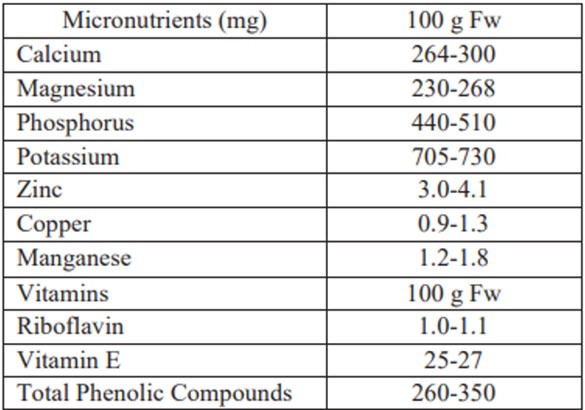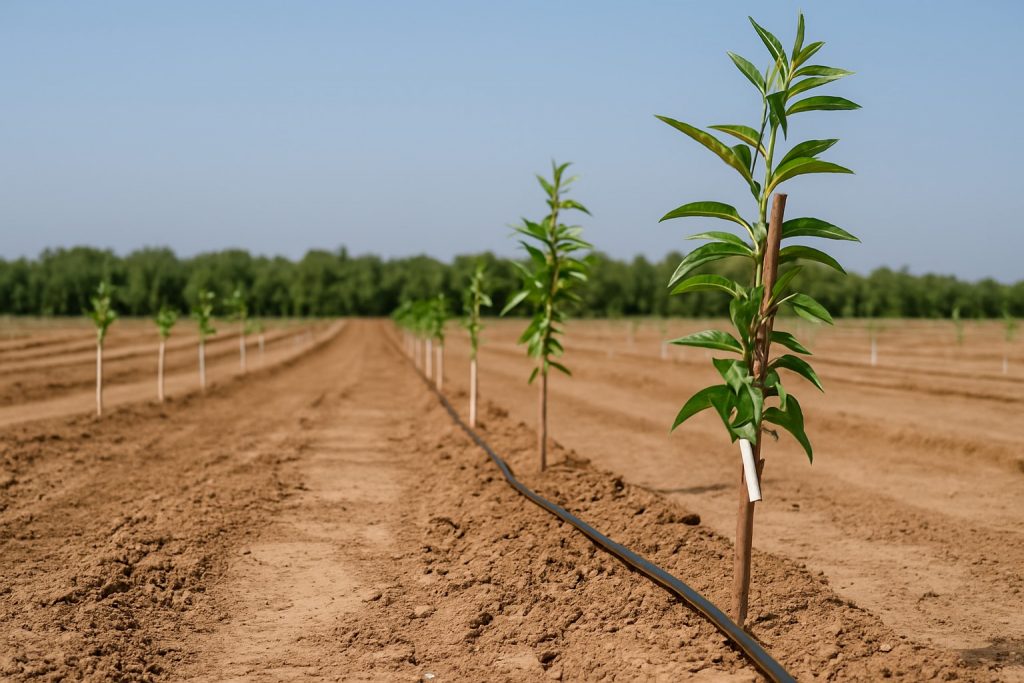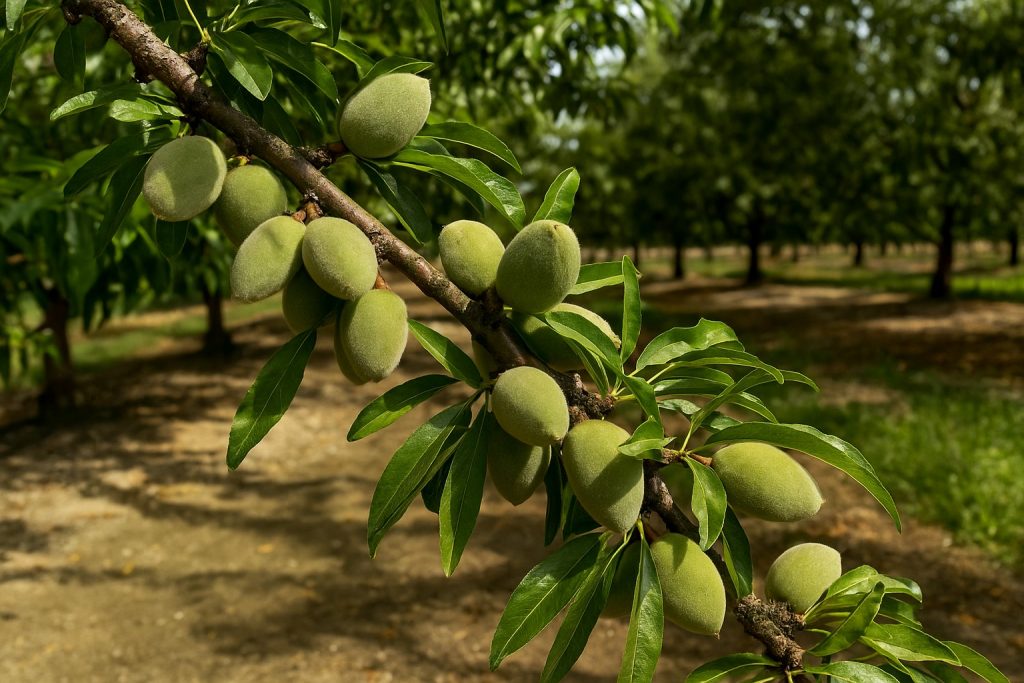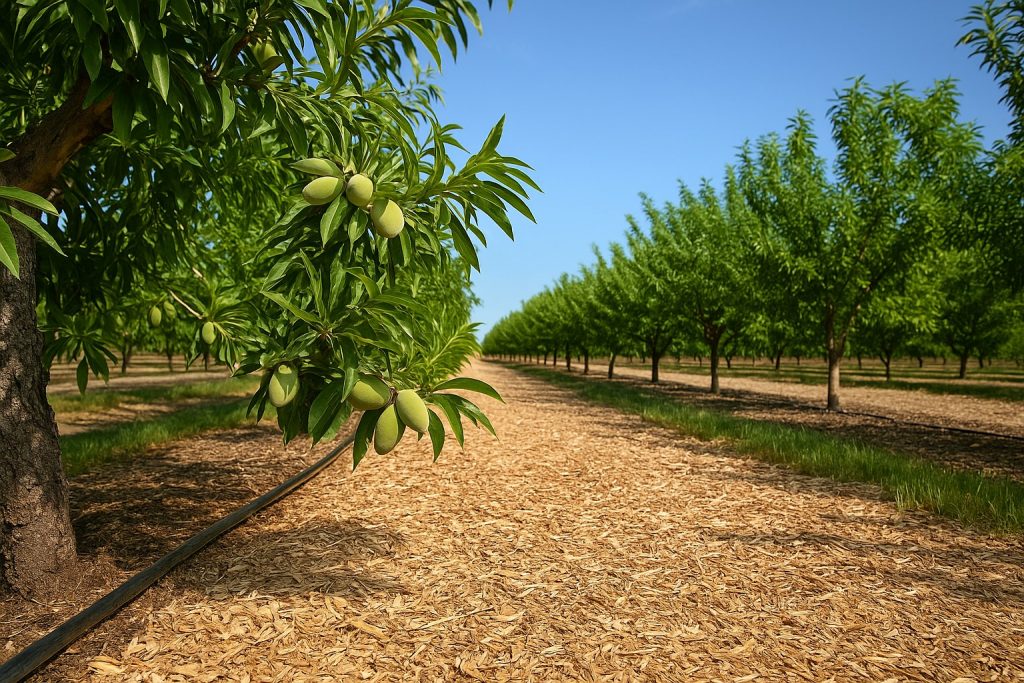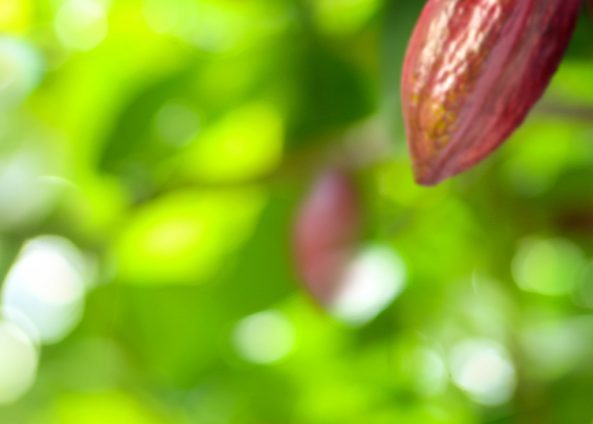
Almond Tree Cultivation Guide
Almond production is a long-term investment that requires detailed planning, consistent orchard care, and precise management throughout the season. This guide provides a clear overview of the key areas involved in successful almond cultivation — from site selection and nutrition to water management, pest control, and post-harvest handling. It includes links to specific technical articles for growers looking to go deeper into each subject.
Crop Introduction and Importance
The almond tree, scientifically known as Prunus dulcis (Mill.) D.A. Webb belongs to the subgenus Amygdalus and is part of the genus Prunus L. in the Rosaceae family. Originally hailing from south-central Asia, it thrives in Mediterranean-like climates. Alongside commercially grown almonds, there exist around 30 wild almond species, typically exhibiting more bitterness than cultivated varieties. Almonds trace back around 5.88 million years and were initially planted in genetically diverse orchards predominated by bitter seedlings. Scientific advancements later uncovered a genetic mutation dictating the sweetness of the kernel, facilitating almond domestication as a staple crop. The sweeter Prunus dulcis resulted from selective breeding of prehistoric populations for enhanced taste. More recently, re-domesticated almond germplasm has been identified to boost nutritional attributes and food safety standards. Almonds rank among the earliest fruit trees to be domesticated, with traces dating back to the Early Bronze Age (3000–2000 BC) in archaeological sites like Numeira (Jordan) and even found in Tutankhamun’s tomb in Egypt around 1325 BC.
Almond kernels are highly nutritious, long-lasting, and boast various medicinal uses, earning a place in ancient medicine and religious texts. Resilient to harsh climates, almond trees exhibit deep, centrifugal root systems, allowing them to thrive in diverse ecological niches typical of Mediterranean regions, characterized by mild, dry winters and warm summers. Currently cultivated in over 50 countries, almond cultivation has extended to less conducive environments due to the creation of new cultivars and enhanced farming technologies in recent decades. The distribution of Prunus dulcis worldwide stems from human-driven dispersals originating in the eastern Mediterranean. Despite its Middle Eastern origins, almond trees are now cultivated globally, including in regions like southern Australia and California. Almonds have evolved into a premium fruit, prominently exported at high values to developed nations, solidifying their status as the world’s foremost nut crop commercially.
According to the Food and Agriculture Organization of the United Nations (FAO), global unshelled almond production has peaked at 3.2 million tonnes, with a major share originating from Mediterranean nations and the United States, representing over 65% of global production. Almonds account for 30% of the total nut consumption globally, with walnuts following closely at 20%. With Europe leading in consumption, North America and Asia trail as significant consumer regions with similar production capacities. Particularly in the United States, sweet almonds dominate nut consumption, surpassing walnut consumption by a substantial margin. Not only does almond production hold economic significance due to its vast output, but it also commands higher prices per kilogram. In California, almonds reign as the leading tree crop based on value, acreage, and global distribution, with major varieties like Nonpareil, Mission, California, Neplus Ultra, and Peerless contributing to the majority of production. Consequently, almonds remain a sought-after commodity, with Mediterranean-grown almonds commanding a higher price compared to Californian counterparts due to their premium quality derived from traditional cultivation practices. The commercial value of almonds is deeply tied to the United States’ continued dominance in global almond exports, as evidenced by substantial shipments to key markets like Spain, Germany, and Japan.
Renowned for their rich nutrient profile, almonds are increasingly favoured as a healthy food choice among consumers and farmers. These versatile nuts are commonly consumed as snacks and find application in various processed foods, particularly bakery and confectionery products. Scientific inquiries into almond composition have underscored their nutritional richness (Table 1 and 2), with studies revealing significant health benefits, such as the potential to reduce total and LDL cholesterol levels when incorporating nuts into daily diets.
Table 1. Almond’s macronutrients (Source: Barecca et al., 2020; Grundy et al., 2016).
Table 2: Almond’s micronutrients (Source: Barecca et al., 2020; Grundy et al., 2016).
Crop Biology and Growth Requirements
Almond trees follow a well-defined seasonal growth cycle, starting with dormancy and progressing through bud development, bloom, fruit set, and nut maturation. Each stage requires specific management actions to support healthy development and maximize productivity. A clear understanding of these phases is key to aligning field practices with the tree’s actual needs.
Learn more: https://www.rivulis.com/almond-crop-biology-growth-requirements/
Almonds Cultivation Practices
Efficient almond production depends on managing several core practices throughout the season. One of the most critical is water usage, which must be carefully aligned with the tree’s growth stage and climate conditions. Learn more about how to optimize irrigation in our article on almond water usage and management. Pest pressure is another key concern, requiring a planned and adaptive integrated pest management (IPM) approach to reduce damage and preserve crop quality. These and other agronomic decisions play a direct role in long-term orchard performance.
Variety Selection
Variety selection is crucial for both new and existing almond orchards. Since most almond varieties require cross-pollination, growers should plant multiple compatible varieties together to ensure optimal fruit set. Several aspects should be considered in addition before planting:
- Adaptation: Choose varieties suitable for the specific climate and soil conditions.
- Pollination: Ensure compatibility between different varieties for effective pollination.
- Bloom timing: Overlapping bloom periods between almond varieties are essential for successful pollination.
- Yield and Quality: Select varieties known for high yields and desired nut characteristics.
- Harvest timing: Selecting almond varieties with staggered maturity dates is crucial to spreading out the workload and associated costs during harvest. Ideally, almond varieties should maintain fruit quality while minimizing fruit drop during ripening, yet still be easily harvested.
- Disease resistance: Selecting varieties resistant to common local pests and diseases is crucial. However, it’s important to recognize that a variety’s resistance to specific pests and diseases can be significantly influenced by growing conditions, including climate, soil quality, water quality and availability, and the population levels of the pest or disease agent, as well as their vectors.
- Market demand for kernel quality: Identifying target markets is essential for almond variety selection. Thorough market research helps understand consumer preferences. However, it’s equally important to include varieties with potential appeal for emerging markets to diversify risk and capitalize on future opportunities.
California is the world’s leading almond producer, cultivating around 30 varieties, though only 13 dominate the market. These varieties are primarily classified into three categories: Nonpareil, Mission, and California.
- Nonpareil: This is the most prominent variety, known for its large, uniform, and light-coloured kernels. It commands a premium price due to high consumer demand. Many other varieties, such as Sonora and Independence, have been developed as pollinators for Nonpareil and share similar characteristics.
- Mission: Characterized by small, dark, and wrinkled kernels, Mission varieties are primarily used in roasted, salted, and confectionary products. Butte, Padre, and Fritz are the main varieties in this group.
- California: Developed for blanching and slicing or slivering, this category includes a wide range of kernel sizes and shapes. Many varieties in this group are also used for roasting and snacking. Carmel, Monterey, and Wood Colony are examples, though their production or usage might decline due to specific characteristics.
Industry Challenges
The almond industry faces challenges in maintaining consistent quality and meeting diverse consumer preferences. The classification of varieties is evolving as new cultivars emerge and market demands change. Factors such as kernel size, shape, colour, and blanch ability influence variety selection and product development.
Key Takeaways
- In general, the almond industry is centred around a few dominant varieties with specific characteristics.
- The classification of almond varieties is based on kernel attributes and end-use applications.
- The industry is dynamic, with new varieties and market trends impacting production and processing.
- There is a need for ongoing research and development to address industry challenges and meet consumer demands.
Source: Almond Board of California Report-Almond Varieties and Selection;
Water Management:
Almond trees require consistent and efficient water supply throughout their growth cycle, particularly during bloom, nut set, and kernel fill. Effective irrigation scheduling, system design, and water quality monitoring are key to maximizing yield while conserving resources. Learn how to align irrigation practices with tree demand, avoid water stress, and manage application efficiency in our article on almond water usage and management.
Nutrient Management
A strong nutrient management strategy is essential to support healthy tree development and maximize almond yields. From bud break through kernel development, almond trees rely on well-timed, balanced fertilizer applications to meet their seasonal nutritional needs. Understanding what the trees need—and when—is key to long-term orchard success.
Learn more in our full article on Nutrient Management in Almond Orchard.
Almond Fertilizer Requirements
Almond trees follow specific nutrient demand curves that vary across the season. Fertilizer timing and application rates should match periods of high uptake, such as early shoot growth and fruit development. Efficient programs are built on crop models and real-time monitoring to avoid over- or under-application.
Function and Importance of Macronutrients and Micronutrients
Macronutrients like nitrogen, phosphorus, and potassium are vital for tree growth and fruit formation, while micronutrients such as zinc and boron play critical roles in flower development and nut quality. A balanced nutrient approach ensures sustained productivity and orchard health.
Pest and Disease Management
Managing pests and diseases is a year-round responsibility in almond orchards. Early identification, preventative practices, and timely interventions are essential to protect yield and ensure healthy tree development. Effective programs rely on monitoring tools, economic thresholds, and integration of biological and chemical controls tailored to seasonal risks. Growers must also consider resistance management and environmental factors when selecting treatments.
Explore the full approach in our guide to pest and disease management in almond orchards.
Almond Harvesting and Post-Harvest Handling
Harvesting almonds at the right time and using proper techniques is critical for protecting nut quality and maximizing returns. Key considerations include monitoring hull split timing, using mechanical shakers effectively, and managing drying and collection procedures. Post-harvest practices like cleaning, sorting, and proper storage conditions directly impact marketability and shelf life.
Discover best practices in our full article on Almond Harvesting and Post-Harvest Handling
Environmental Sustainability
Water Conservation: Adopt water-saving irrigation technologies and practices.
Best Strategies for Water Conservation in Almond Orchards
Almond orchards can be water-intensive, but there are several effective strategies to conserve water without compromising yield or quality. Here are some key approaches:
1. Efficient Irrigation Systems:
- Drip irrigation: This system delivers water directly to the root zone, minimizing evaporation and runoff.
- Micro-sprinklers: Similar to drip irrigation, these emit water in a fine mist, reducing water loss.
- Smart irrigation systems: These use sensors to monitor soil moisture and adjust irrigation schedules accordingly.
2. Soil Moisture Monitoring:
- Tensiometers: These devices measure soil moisture tension, helping farmers determine when irrigation is necessary.
- Time domain reflectometry (TDR): This technology provides real-time measurements of soil moisture content.
3. Water-Efficient Almond Varieties:
- Drought-tolerant cultivars: Selecting varieties that are naturally more resistant to water stress can help reduce irrigation needs.
4. Soil Management Practices:
- Soil Mulching: Mulch can significantly improve soil moisture retention, reduce weed growth, and promote root development in plants. By creating a protective layer over the soil, mulch helps prevent water evaporation, which can lead to increased soil moisture levels and reduced weed competition.
Mulching is a common practice in agriculture to reduce soil moisture loss. However, when it comes to almond orchards, surface mulching can pose challenges.
To mitigate these issues, some growers have experimented with incorporating mulch near drip irrigation lines. This method helps prevent mulch loss and reduces the risk of kernel contamination during harvest.
Additionally, mulches can encourage deeper root growth, allowing plants to access more water and nutrients. Studies have shown that organic mulches are particularly effective at promoting root development compared to plastic or living mulches.
It’s crucial to use certified mulch, especially when sourcing from animal or green waste, as contaminants like glass can pose a problem. While many in the industry recognize the potential benefits of mulch incorporation, further research and development are needed to address contamination concerns.
Therefore, implementing mulching strategies in almond orchards requires careful consideration and planning.
- Cover crops: Planting cover crops between rows can improve soil health and reduce water runoff.
- Soil amendments: Adding organic matter to the soil can enhance its water-holding capacity. Adding organic matter to the soil can significantly boost its ability to hold water. This is due to the increased pore space created by the organic material, which can act as a sponge, absorbing and retaining moisture.
Studies have shown that organic matter can hold up to 20 times its weight in water. For every 1% increase in soil organic matter, the available water-holding capacity can improve by nearly 4%. This means less irrigation is needed to maintain crop health and productivity.
5. Irrigation Scheduling:
- Deep irrigation: Applying less frequent but deeper irrigations can encourage deeper root growth, making trees more resilient to drought.
- Irrigation at night: Irrigating during cooler night hours can reduce evaporation losses.
6. Water Harvesting:
- Rainwater harvesting: Collecting rainwater and storing it for irrigation can supplement water supplies.
- Graywater recycling: Reusing treated wastewater from household activities can be a valuable source of irrigation water.
7. Precision Agriculture Technologies and Practices:
- Remote sensing: Using drones or satellites to monitor crop health and water use can help optimize irrigation practices.
- Data analysis: Analysing data from sensors and other sources can provide insights into water management needs.
- Soil Health: Implement practices to improve and maintain soil health.
- Pollinator Protection: Create habitats for pollinators like bees.
8. Integrated Pest, Disease and Soil Management
Integrated Pest, Disease, and Soil Management (IPDSM) in Almonds: A Crucial Approach
IPDSM is a holistic approach to managing pests, diseases, and soil health in almond orchards. By combining biological, cultural, and chemical controls, IPDSM aims to minimize the use of synthetic pesticides while maintaining crop productivity.
Key Benefits of IPDSM in Almonds:
- Environmental Protection: Reduces the environmental impact of pesticide use by minimizing pollution of water bodies, air, and soil.
- Pest and Disease Resistance: Promotes the development of natural pest and disease resistance in almond trees, reducing the need for constant chemical interventions.
- Soil Health: Improves soil health by promoting beneficial microorganisms and reducing soil erosion.
- Cost-Effectiveness: Can be more cost-effective than relying solely on chemical control, as it often involves less expensive practices like cultural controls and biological agents.
- Consumer Preference: Increasingly, consumers prefer products that are produced using sustainable and environmentally friendly methods. IPDSM aligns with this trend.
Key Components of IPDSM in Almonds:
- Cultural Controls:
- Proper orchard sanitation to remove sources of pests and diseases.
- Use of resistant almond varieties.
- Appropriate pruning and irrigation practices to promote tree health.
- Biological Controls:
- Introduction of beneficial insects, such as ladybugs and lacewings, to prey on pests.
- Use of biological agents, like bacteria or fungi, to control diseases.
- Application of organic fertilizers to promote soil health and microbial activity.
- Chemical Control:
- Use of pesticides as a last resort, only when necessary and in accordance with IPM guidelines.
- Selection of pesticides with minimal environmental impact.
- Proper application of pesticides to avoid non-target impacts.
9. Cover crop
Cover Crops in Orchards
Cover crops are non-crop plants grown in orchard row middles to improve soil health and reduce erosion. They can be either specific plantings or naturally occurring vegetation. Cover crops increase orchard water use due to their transpiration and evaporation. However, their positive impacts on soil structure and water infiltration often offset this increased water consumption over time.
Factors influencing cover crop water use include type, density, mowing frequency, and tree canopy shading. Accurately measuring cover crop water use is challenging and varies significantly by location.
Benefits and Management of Cover Crops
Benefits of Cover Crops
Cover crops offer numerous advantages for orchard management:
- Soil Health Improvement: Enhance soil structure, organic matter content, and water infiltration.
- Erosion Control: Protect topsoil from wind and water erosion.
- Nutrient Management: Prevent nutrient leaching and improve nutrient cycling.
- Weed Suppression: Reduce competition from weeds.
- Biodiversity Enhancement: Support beneficial insects and pollinators.
- Climate Regulation: Contribute to carbon sequestration and temperature moderation.
Cover Crop Management Strategies
Effective cover crop management is essential to maximize benefits while minimizing potential drawbacks. Key considerations include:
- Species Selection: Choose cover crops that are well-suited to local climate, soil conditions, and orchard management practices. Consider factors such as growth habit, nitrogen fixation, and biomass production.
- Planting Timing: Determine the optimal planting time to balance cover crop growth with orchard operations.
- Termination: Select appropriate methods for terminating cover crops (e.g., mowing, herbicide, tillage) based on desired outcomes and timing.
- Integration with Orchard Practices: Coordinate cover crop management with other orchard activities, such as pruning, harvesting, and fertilization.
- Monitoring and Evaluation: Regularly assess cover crop performance and adjust as needed.
Sustainability Considerations
Sustainability in almond farming goes beyond reducing water use — it includes improving soil health, supporting biodiversity, managing inputs responsibly, and reducing environmental impact throughout the production cycle. Growers are increasingly adopting practices such as cover cropping, precision irrigation, and integrated pest management to support long-term orchard viability while responding to environmental and market expectations.
Read more in our article on Almond Sustainability Considerations.
Economic Considerations
- Market Analysis: Understand market demands for almond types and qualities.
- Cost Management: Implement efficient practices to control production costs.
- Risk Management: Consider factors like crop insurance and price fluctuations.
Almond Production Economic Considerations: A Deeper Dive
Market Analysis
- Almond Types and Qualities: Research the current and projected demand for different almond types (e.g., nonpareil, mission, marcona) and qualities (e.g., size, shape, flavor, oil content). This information will help you tailor your production to meet market preferences.
- Export Markets: Explore opportunities for exporting almonds to international markets. Analyse import regulations, tariffs, and transportation costs to identify profitable export destinations.
- Consumer Trends: Stay updated on consumer trends and preferences, such as the growing demand for organic, non-GMO, and specialty almonds.
- Competitive Landscape: Assess the competitive landscape within the almond industry, including major producers, pricing strategies, and market share.
Cost Management
- Production Costs: Break down your production costs into various categories, such as labor, land, water, fertilizer, pesticides, harvesting, processing, and transportation. Identify areas where you can reduce costs without compromising quality.
- Efficient Practices: Implement efficient practices to minimize waste and maximize resource utilization. This includes optimizing irrigation systems, using precision agriculture techniques, and reducing pesticide use.
- Negotiate with Suppliers: Negotiate favourable terms with suppliers of inputs such as fertilizer, pesticides, and equipment to lower costs.
- Diversify Income: Consider diversifying your income by producing other crops or offering value-added products like almond flour, almond milk, or almond oil.
Risk Management
- Crop Insurance: Purchase crop insurance to protect your investment against losses due to adverse weather conditions, pests, diseases, or market fluctuations.
- Price Fluctuations: Monitor market prices and consider using futures contracts or options to hedge against price volatility.
- Diversification: Diversify your almond production by planting different varieties or growing other crops to reduce your exposure to risks.
- Risk Assessment: Conduct a thorough risk assessment to identify potential threats to your almond production and develop strategies to mitigate them.
Future Trend and Research:
Future Trends in Almond IrrigationAlmond irrigation is a crucial aspect of almond production, and advancements in technology and sustainable practices are driving significant changes in this area. Here are some key future trends:
Precision Agriculture and IoT
- Real-time Monitoring: IoT-enabled sensors will provide real-time data on soil moisture, temperature, and other environmental factors. This will enable farmers to optimize irrigation schedules based on actual plant needs.
- Smart Irrigation Systems: Advances in smart irrigation technology will allow for more precise water delivery, reducing waste and improving water efficiency.
- Data Analytics: Using data analytics, farmers can analyze historical and real-time data to identify patterns and optimize irrigation strategies.
Water Conservation Technologies
- Drip Irrigation: Drip irrigation systems will continue to be a popular choice for almond orchards, as they deliver water directly to the root zone, minimizing water loss through evaporation and runoff.
- Water Recycling: Techniques such as wastewater recycling and rainwater harvesting will become more common to conserve water resources.
- Hydroponics: While less common in almond production, hydroponics offers the potential for significant water savings and controlled growing environments.
Sustainable Irrigation Practices
- Reduced-Till Farming: Minimizing soil disturbance can help improve water infiltration and reduce water runoff.
- Cover Cropping: Planting cover crops between almond trees can help improve soil health, increase water retention, and reduce erosion.
- Salt Tolerance: Research into developing almond varieties with improved salt tolerance will be essential for growing almonds in regions with saline soils.
Climate Change Adaptation
- Drought-Resistant Varieties: Breeding programs will focus on developing almond varieties that are more tolerant to drought conditions.
- Water Management Strategies: Farmers will need to adapt their water management practices to cope with changing climate patterns, such as more frequent and intense heat waves.
As technology continues to advance and climate change becomes a more pressing concern, the future of almond irrigation will be characterized by a shift towards more sustainable, efficient, and data-driven practices.
Other relevant aspects:
Future Trends in Almond Production
The almond industry is evolving rapidly, driven by factors such as consumer preferences, technological advancements, and environmental concerns. Here are some key future trends:
Consumer Trends
- Health and Wellness: The demand for almonds as a healthy snack and ingredient will continue to grow, fueled by their high nutritional value and versatility.
- Sustainability: Consumers are increasingly concerned about the sustainability of the products they consume. Almond producers will need to prioritize sustainable practices to meet this demand.
- Specialty Almonds: There will be a growing demand for specialty almond varieties, such as organic, non-GMO, and flavored almonds.
Technological Advancements
- Precision Agriculture: The use of precision agriculture techniques, such as drones and sensors, will become more widespread in almond orchards, allowing for more efficient and targeted management practices.
- Artificial Intelligence: AI-powered systems can be used to analyse data from sensors and make informed decisions about irrigation, fertilization, and pest control.
- Automation: Automation technologies, such as robotic harvesters, can improve efficiency and reduce labour costs.
Sustainability
- Water Conservation: Almond producers will continue to focus on water conservation strategies, such as drip irrigation, water recycling, and improved irrigation efficiency.
- Soil Health: Maintaining soil health through practices like cover cropping and reduced tillage will be essential for long-term sustainability.
- Biodiversity: Protecting biodiversity in almond orchards will be a priority, including supporting pollinators and conserving natural habitats.
Global Market Dynamics
- Expanding Markets: The almond market is expected to continue to grow, with increasing demand from emerging markets, particularly in Asia.
- Trade Agreements: Trade agreements and policies will play a significant role in shaping the global almond market, including tariffs, quotas, and sanitary and phytosanitary standards.
- Competition: Competition from other nut crops, such as walnuts and pistachios, will intensify, requiring almond producers to differentiate their products and remain competitive.
By understanding these future trends, almond producers can position themselves for success in a rapidly evolving market and contribute to a sustainable and resilient food system.
Future Research Topics in the Almond Industry
Here are some potential areas for future research in the almond industry:
Sustainability and Environmental Impact
- Water Conservation: Developing new irrigation technologies and practices to further reduce water consumption in almond orchards.
- Soil Health: Investigating strategies to improve soil health and fertility, such as cover cropping and organic farming practices.
- Pollinator Health: Researching ways to promote pollinator health and biodiversity in almond orchards.
- Carbon Sequestration: Exploring the potential of almond orchards to sequester carbon and contribute to climate change mitigation.
Disease and Pest Management
- Resistant Varieties: Breeding almond varieties that are resistant to common diseases and pests, such as powdery mildew and almond hull borer.
- Integrated Pest Management (IPM): Developing and refining IPM strategies to minimize the use of chemical pesticides while effectively controlling pests and diseases.
- Biological Control Agents: Identifying and utilizing biological control agents to combat pests and diseases in almond orchards.
Technology and Innovation
- Precision Agriculture: Applying precision agriculture techniques, such as remote sensing and data analytics, to optimize almond production.
- Automation: Developing and implementing automated systems for tasks such as harvesting, sorting, and processing almonds.
- Genetic Engineering: Exploring the potential of genetic engineering to improve almond yield, quality, and resistance to environmental stresses.
Market and Consumer Trends
- Consumer Preferences: Understanding evolving consumer preferences for almond products, such as flavor profiles, sustainability certifications, and health benefits.
- Global Markets: Identifying new export markets for almonds and developing strategies to penetrate these markets.
- Value-Added Products: Researching and developing new value-added almond products to increase market diversification and profitability.
Climate Change Adaptation
- Heat Tolerance: Breeding almond varieties that are more tolerant to extreme heat and drought conditions.
- Irrigation Efficiency: Developing irrigation systems and strategies that are more resilient to climate change and can adapt to changing water availability.
- Carbon Farming: Exploring the potential of almond orchards to implement carbon farming practices and generate carbon credits.
By investing in these research areas, the almond industry can continue to innovate, improve sustainability, and meet the evolving needs of consumers and markets.
Rivulis Solution:
Rivulis offers a comprehensive range of solutions, including not only advanced irrigation systems but also innovative technologies for climate control.
In the area of climate control, Rivulis provides solutions such as:
- Net and Greenhouses: For annual and fruit crops.
- High-tech precision cooling systems: To maintain optimal temperatures for
sensitive crops. - Anti-freeze systems: To protect crops from frost damage during vulnerable
phenological stages like flowering and fruit setting.
These climate control solutions are particularly valuable during the spring and autumn seasons when many crops are susceptible to extreme weather conditions.
For more solutions visit: https://www.rivulis.com/crop/nuts/
Conclution
Almonds have been cultivated for centuries, and their popularity continues to grow due to their nutritional value, versatility, and delicious taste. The almond industry has evolved significantly over time, adapting to changing consumer preferences, technological advancements, and environmental challenges.
In the past, almond production was primarily focused on traditional agricultural practices. However, advancements in technology, such as irrigation systems and pest control methods, have revolutionized the industry. Today, almond farmers utilize a variety of modern techniques to optimize production efficiency and minimize environmental impact.
Looking ahead, the future of almond production is promising. As consumer demand for healthy and sustainable food products continues to rise, almonds are well-positioned to meet this need. Technological advancements, such as precision agriculture and artificial intelligence, will further enhance almond production efficiency and sustainability. Additionally, ongoing research into new almond varieties and improved farming practices will help the industry adapt to changing climate conditions and market trends.
In conclusion, the almond industry has a rich history and a bright future. By embracing innovation, sustainability, and consumer-driven trends, almond producers can continue to thrive and contribute to a healthy and sustainable food system.


